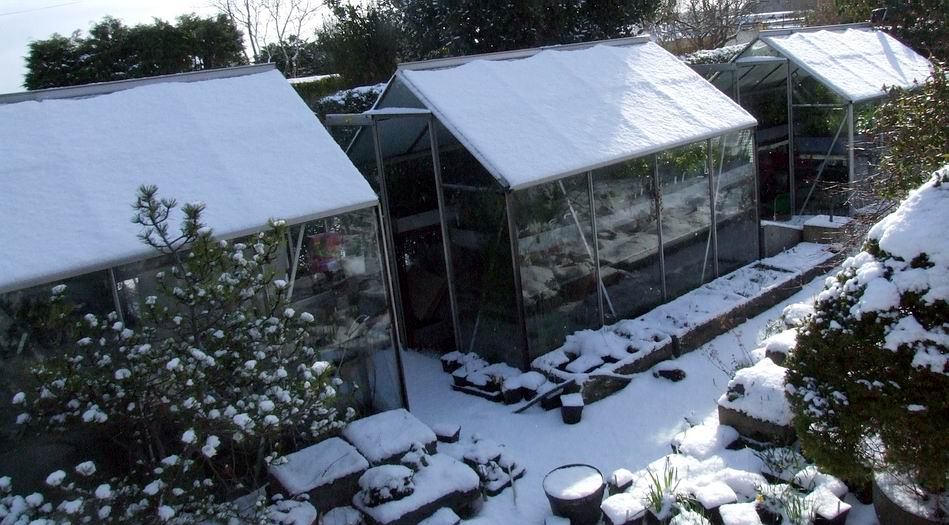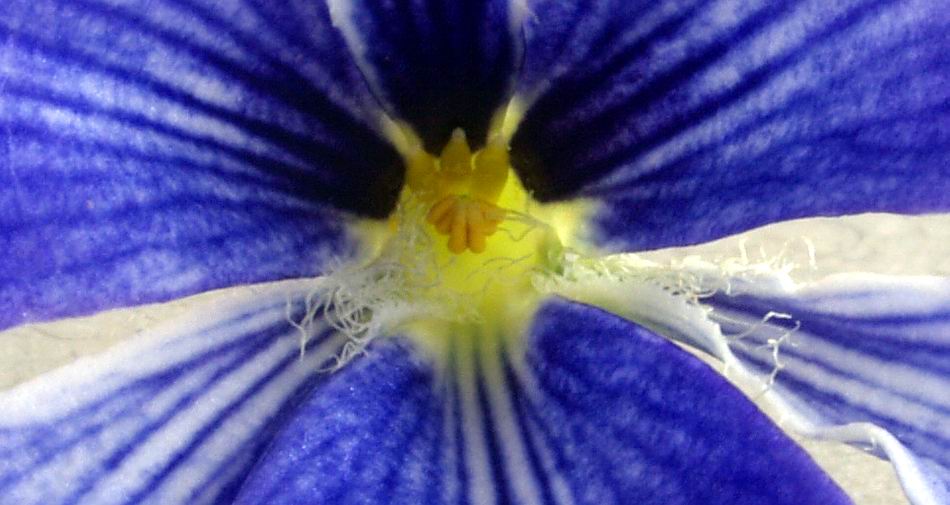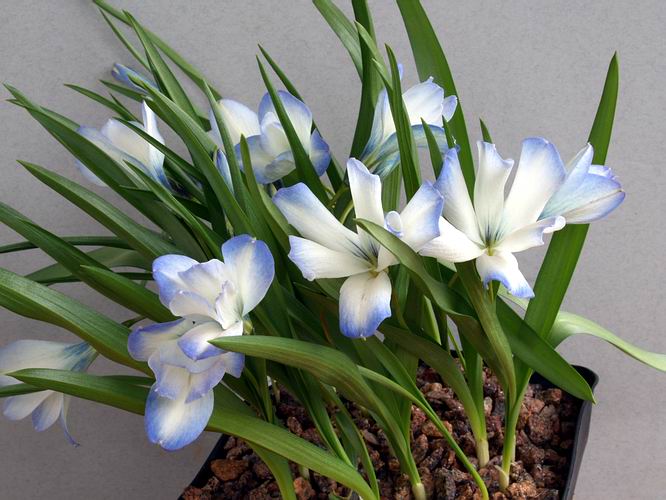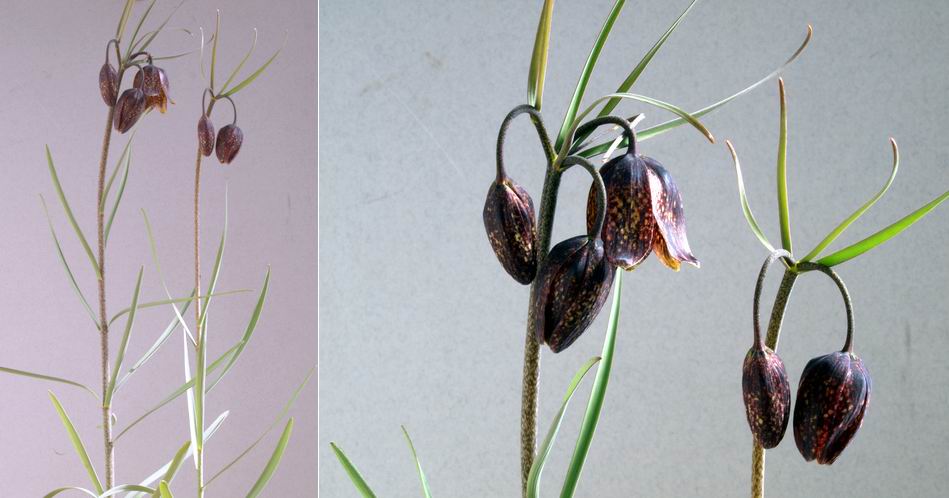|
BULB LOG 13 --- 26th March 08

Snow on Bulbhouses in March
Once again our weather has turned cold and we are getting snow in March - I would not mind if we got cold in December, January and February when it supposed to be winter. When winter comes after spring it causes more problems as the bulbs have been advanced into growth by the warm temperatures of the last few months and now they are all freezing.

Fritillaeria raddeana in snow
Fortunately most of the bulbs we grow are well used to coping with these fluctuating conditions which also occur in the wild and have done for many thousands of years as the bubs have evolved a strategy to survive in the cold even when they are in growth. Above you can see among others Fritillaeria raddeana which just lies down on the ground during freezing conditions - when the temperature rises it just stand up again and I have never see any lasting damage from the frosts.

Frozen Fritillaria sewerzowii
Another day of cold and another frit has the same strategy - Frozen Fritillaria sewerzowii - both these Central Asian frits come from habitats where they will experience freezing conditions when they are in flower.

Tecophilaea detail
Blue is often a colour associated with the cold but there is nothing cold about the very beautiful Tecophilaea cyanocrocus from Chile, South America. I have never tried it outside in Aberdeen but it is perfectly hardy under cold glass conditions where I can control the watering. I do intend to plant a few corms outside in my new experimental sand bed.

Tecophilaea flowers
Tecophilaea cyanocrocus is a single species with a number of colour variations that have been given varietal status. In the picture above I have shown, from the left; Tecophilaea cyanocrocus var. violacea, Tecophilaea cyanocrocus, Tecophilaea cyanocrocus, and then two selected forms of Tecophilaea cyanocrocus var leichtlinii.

Tecophilaea cyanocrocus
The species is famed for its stunning blue colour and it is easy to see why it is often called the Chilean blue crocus. This is a young seedling which like all bulbs raised from seed exhibits a glow and vigour that only the young bulbs can have - as they age they are just like us and lose their gloss. What is it that they say? - 'old age does not come alone'.

Tecophilaea cyanocrocus var. violacea1

Tecophilaea cyanocrocus var. violacea 2
I have shown two pictures of the violet form, Tecophilaea cyanocrocus var. violacea to try and show the true colour - a royal purple. It is normally blues that people have trouble capturing in pictures but I have found over the years that is the colour of Tecophilaea cyanocrocus var. violacea which is almost impossible to represent in either film or digital. I have tried to manipulate the colour by adding red but by the time I get any where near the flower colour the background is a very unrealistic colour. There is no doubt that the image that comes through our eyes is adjusted by our brain to take into account the light values before we see it. The right hand image of the second picture is closest to how I see var violacea.

Tecophilaea cyanocrocus var leichtlinii
Tecophilaea cyanocrocus var leichtlinii is named because it has a greater area of white in the throat. I am not sure at what degree of white in the throat Tecophilaea cyanocrocus turns into var leichtlinii but then that is why it is a variety and not a sub- species. I think the one above is a very typical form of Tecophilaea cyanocrocus var leichtlinii.

Tecophilaea 'Craigton Cloud'
Even though these different colour forms are only varieties they I have always found that they come true from seed with the odd exception when they cross with each other - 'Storm Cloud' which I do not grow, is a cross between leichtlinii and violacea. Over the years I have been selecting the whiter forms of var leichtlinii, which only goes to show how obtuse gardeners are. When a plant is fabled for its outstanding blue colour why on earth should I be trying to raise a white form - you may well ask. I suppose it is because it occurs and Tecophilaea 'Craigton Cloud' was one of my early seedlings which I named.

Tecophilaea 'Craigton Cloud' flower
It is a nice flower that is more white than blue and was selected from a pot of seedlings I raised from the seed taken from our own plants of leichtlinii.

Tecophilaea 'Craigton Snowdrift' pot
Another seedling from the same generation has even less blue and this I named

Tecophilaea 'Craigton Snowdrift' .
'Craigton Snowdrift' only has some blue towards the ends of the petals and it looks very good when it is displayed in with the other forms of Tecophilaea. I always think that mixed colours of any plant look good when growing in mixed drifts and when there are white forms included the effect is even greater.

Tecophilaea seedling flowers
Here is a second generation seedling grown from seed taken from 'Craigton Snowdrift' - these are all individual clones and they are all very similar to their seed parent and difficult to separate out by colour. Maybe in another few generations I will get a pure white form but I still like the blue of the type, Tecophilaea cyanocrocus, the best.

Fritillaria nigra
Now for a few frits that have different names but all look just the same. Fritillaria nigra is the name that I got this plant as many years ago. Fritillaria nigra is a name that was applied to Fritillaria pyrenaica but this plant has nothing to do with that species. It is part of the Fritillaria montana complex, as I call this group of very similar looking tallish brown flowered frits. I still keep the old names to help identify the source but it looks to me that this is a form of Frit montana.

Fritillaeria nigra 2
Another more tessellated form that I also got as Fritillaeria nigra also fits neatly into the description of F. montana.

Fritillaria tenella
Fritillaria tenella is synonymous with F. orienatalis but this plant I believe is yet another form of F montana as are many of the so called bulbs of F. orientalis that I have raised. I will show F. orientalis when it comes into flower but it is very different and one of the main differences is the way the stem comes out of the ground not at right angles but almost sideways. Because these frits produce generous quantities of offsets, not so much rice grains but very short stolon-like bulbils, they have been widely distributed around, in Scotland at least. I should finish by saying that whatever you wish to call them they are fine plants well worth having and are they also hardy in the garden.
^ back to the top ^
|

